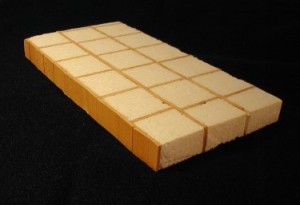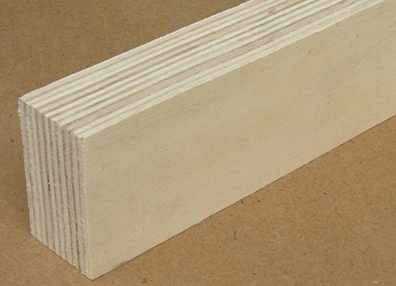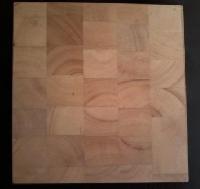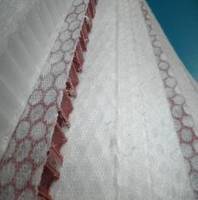Applications -> Building Components -> Doors -> Sing Door Core
 What is Sing Door Core?
What is Sing Door Core?
- It is the patented foundation of all Sing Doors
- May be the core of true green revolution, if you believe in
- the renewable structure of Sing Door Core
- saving energy
- lightweight
- high-strength
- affordable
Sing Core is based on torsion box technology that has been used in the wood working trade for thousands of years, and is often compared to lightweight core, honeycomb core and other composite building materials in the industry. It is also compared to SIP (structural insulated panels) with the exception that structural insulated panels actually do not have the structural grids that are necessary for strength, making SIP less than 10% the strength of Sing Core.
- dimension: 12 inch x 48 inch to 4 ft x 8 ft
- thickness from 1/2 inch to 6 inch.
See More information on: Sing Core
Compare to Other Types of Door Core
The most popular core material used in retail doors is paper core also known as cardboard core and honeycomb core. The most attractive feature of paper core is that it is light weight, nearly as lightweight as hollow core, with very little added strength. These lightweight doors are often used in apartment buildings and housing units because they are lightweight and less likely to injure children in door-related accidents. The downside is that there is no structural integrity and it is not long before the door fails due to warp, bend or twist. Paper core doors also have no insulative or sound-deadening qualities and are fairly easy to damage as it does not take much to puncture, crack or break a paper core door.
Foam Door Core
 The next most popular core used in retail doors is foam core. While still yielding a lightweight door, much like the paper core, it also does not have any strength. Foam has a very low compression strength (+/- 10 PSI) resulting in high failure rates, and will not remain straight as the only strength in the foam core door is provided by the exterior skin material. To achieve strength, more heavy material must be added to the surface of the door, cancelling out the lightweightedness of the door. While a stronger foam core door may be extremely heavy due to reinforcement, the foam will offer some insulative value and limited sound deadening.
The next most popular core used in retail doors is foam core. While still yielding a lightweight door, much like the paper core, it also does not have any strength. Foam has a very low compression strength (+/- 10 PSI) resulting in high failure rates, and will not remain straight as the only strength in the foam core door is provided by the exterior skin material. To achieve strength, more heavy material must be added to the surface of the door, cancelling out the lightweightedness of the door. While a stronger foam core door may be extremely heavy due to reinforcement, the foam will offer some insulative value and limited sound deadening.
Particle Board Door Core
 Particle board is the third-most popular core used in retail doors. Customer seeking a higher quality door than paper or foam core are often persuaded to purchase the particle board core door because it appears to be a real door, especially when compared to the lighter weight doors on the sales floor. The heaviness of the door implies that the door has strength in comparison to the less expensive paper or foam core doors; only much heavier, particle board doors do not offer much additional strength, and commonly fail over time (though it is harder to punch-through a particle board door than a paper or foam core door).
Particle board is the third-most popular core used in retail doors. Customer seeking a higher quality door than paper or foam core are often persuaded to purchase the particle board core door because it appears to be a real door, especially when compared to the lighter weight doors on the sales floor. The heaviness of the door implies that the door has strength in comparison to the less expensive paper or foam core doors; only much heavier, particle board doors do not offer much additional strength, and commonly fail over time (though it is harder to punch-through a particle board door than a paper or foam core door).
LVL Door Core
 LVL door core is a reasonable solution for door core, as it consists of multiple layers of veneer bonded together to make a solid core material. The problems that result from LVL come from resulting in an extremely heavy door that will not survive changing temperatures very well over time. Though it does have some warp and twist resistance, failure is experience in the long term effects that lead to delamination. Once the lamination in the door’s interior begins to fail, the door will not function properly and may become unsightly.
LVL door core is a reasonable solution for door core, as it consists of multiple layers of veneer bonded together to make a solid core material. The problems that result from LVL come from resulting in an extremely heavy door that will not survive changing temperatures very well over time. Though it does have some warp and twist resistance, failure is experience in the long term effects that lead to delamination. Once the lamination in the door’s interior begins to fail, the door will not function properly and may become unsightly.
Solid Wood Door Core
 Solid wood core is expensive because it uses a large amount of precious natural resources and for traditional enthusiasts it is sought out for the sake of originality and/or trueness to nature, though it is not a responsible use of natural resources. Solid wood doors have no insulation or sound deadening qualities are heavy and have little or no structural integrity due to the nature of the characteristics of the natural grain. The solid wood doors often fail due to bend, warp, twist and will not be able to secure properly.
Solid wood core is expensive because it uses a large amount of precious natural resources and for traditional enthusiasts it is sought out for the sake of originality and/or trueness to nature, though it is not a responsible use of natural resources. Solid wood doors have no insulation or sound deadening qualities are heavy and have little or no structural integrity due to the nature of the characteristics of the natural grain. The solid wood doors often fail due to bend, warp, twist and will not be able to secure properly.
Balsa Wood Core
 There are several advantages to using balsa wood as door core. Balsa wood is an excellent alternative to other types of core, because it is a natural organic product, but the problem is that it is in short supply making it a more expensive resource and does not fare well when exposed to water (acting like a sponge soaking up water and moisture). Also, since it is a natural wood grain source material, it is prone to warp, bend and twist, just like any other natural wood fiber door core.
There are several advantages to using balsa wood as door core. Balsa wood is an excellent alternative to other types of core, because it is a natural organic product, but the problem is that it is in short supply making it a more expensive resource and does not fare well when exposed to water (acting like a sponge soaking up water and moisture). Also, since it is a natural wood grain source material, it is prone to warp, bend and twist, just like any other natural wood fiber door core.
Plastic Core
 Plastic door core is a good upgrade from paper core in that it is still lightweight, is resistant to moisture but doesn’t offer any other benefits over paper core except for a minor increase of strength. Plastic core is still weak/unstable, non-insulated and can be damaged or will fail easily within a short lifespan.
Plastic door core is a good upgrade from paper core in that it is still lightweight, is resistant to moisture but doesn’t offer any other benefits over paper core except for a minor increase of strength. Plastic core is still weak/unstable, non-insulated and can be damaged or will fail easily within a short lifespan.

